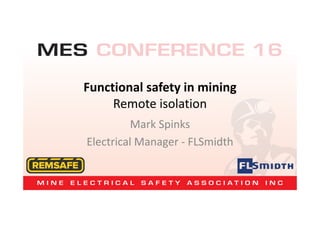
MESA 2016 Presentation - Mark Spinks - Remote Isolation
- 1. Functional safety in mining Remote isolation Mark Spinks Electrical Manager - FLSmidth
- 2. What is functional safety (FS)? • Exida: “Freedom from unacceptable risk achieved through the safety lifecycle.” • Wikipedia: “…the part of the overall safety of a system… that depends on the system… operating correctly in response to its inputs, including the safe management of likely operator errors, hardware failures and environmental changes.” • Marcus Punch: “Correct operation in response to inputs”. • For us, it’s typically in relation to E/E/PS (Electrical, Electronic and Programmable Systems.) • A way of managing the reliability of safety-related electrical systems.
- 3. Where is functional safety (FS)? • It’s everywhere... Image credit: IEC FS overview document
- 4. Remote Isolation: a great application for FS • Some sobering reading: AS4024.3611 Appendix B – While this only covers conveyor-related fatalities, there would no doubt be similar stories on other machines. • As history shows, while the site procedure may be clear, people take short cuts and ‘push the limits’ of what’s acceptable. • We can however take away one of the common reasons (excuses) people take shortcuts – we can make isolation quick and easy. • At the same time, we can make isolations more reliable.
- 5. Remote Isolation – why bother?! • The big one: Human factors (discussed next) • Removal of personnel from the line of fire during isolation. – Consider just the arcflash risk reduction for some installations. • Also, faster isolations can result in some welcome byproducts: – More maintenance completed during an outage, or: – A shorter outage (more plant uptime: more revenue*) *System payback typically occurs within months.
- 6. Unsafe Acts Unintended Action Slips Attention failures Lapses Memory failures Intended Action Violations Routine or exceptional deviations Mistakes Rule or knowledge- based mistakes Human Error James Reason’s Model
- 7. Human Factors - SLIPS Attention Failures – knowing what to do, but accidentally getting it wrong • Failing to identify a necessary isolation point, despite being competent. • Inadvertently turning an isolation point to on, rather than off. • Knowing where to isolate, but operating the wrong handle. Image above: From Qld DNRM safety alert# 163
- 8. Human Factors - LAPSES Memory Failures – knowing what to do, but forgetting in that instance • Forgetting to controlled-stop a process before isolating it • Opening, but forgetting to rack-out a CB isolation point • Forgetting to properly verify the isolation.
- 9. Human Factors – MISTAKES ‘But I thought…’ kind of issues • Misunderstanding which isolation points should be isolated for a task. • Not effectively verifying the isolation, due to lack of knowledge, or other challenges (for example, the belt may have already been stopped for another reason, or isolated by another employee) • Not effectively securing the isolation. • Isolating correctly, but working on the wrong (un-isolated) equipment
- 10. Human Factors - VIOLATIONS Deliberate deviation from procedure. May be routine, or exceptional. Not isolating correctly or fully due to: • Time pressures (real or perceived). • Belief that the belt will not start without all permissives ready. • The imbalance between perceived risk and the effort or time required to isolate.
- 11. Common misconception #1: “Conventional isolations are better. Remote isolations are done through control systems and therefore not as good”.
- 12. Reducing the risk of an isolation-related incident An isolation- related incident
- 13. Common misconception #2: “Remote isolations are not WHOLE CURRENT isolations, therefore no good”. • Not true. Whole current isolations are performed, however these are initiated via a control system. • Verification of effectiveness is also inherent in the design (See image at right, where REMSAFE’s lockout flap is not released by the system until after verification) • Constant isolation status-monitoring is introduced and will take action if anything changes. • Again, consider the arcflash advantages of remotely switching whole-current isolation points. REMSAFE will not allow personnel to apply a lock until the system has verified the isolation.
- 14. Financial benefits • Imagine being able to perform a fully effective isolation, in a few minutes. • Particularly for common (ie regularly conducted) isolations, or complex isolations (which take time to complete). • Revenue increase can be very significant, particularly for bottleneck processes. • Also, means more ‘spanner time’ for skilled personnel • Financial calculators available on the web
- 15. Can we design a system ourselves? • Absolutely, but it’s challenging to do it well. • Recommendations: – Engage an expert supplier – Engage a FSEng to assist (eg TUV certified) – In any case, please don’t forget the ongoing maintenance/proof-testing (discussed next). – Also, consider in advance how to safely bypass the system, should it fail. Image courtesy of Marcus Punch
- 16. Testing Image credit: Drager FS document
- 17. Testing(cont’d) Image credit: E&H FS document
- 18. Remote Isolation - Summary • Financial – Cost of a system can be quickly offset by productivity increases • Safety – Makes isolations quick and easy (no excuses for not isolating) – Less chance of human error – Removes personnel from the line of fire – Constant status-monitoring makes isolations more reliable